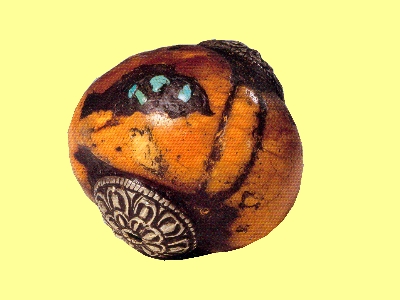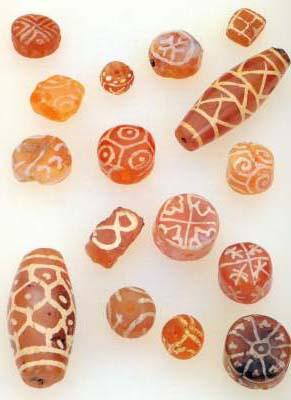Beads and jewelry in the tibetan culture
Tibetan Jewelry
 Despite its natural inaccessibility Tibet was only temporarily a forbidden country. Although we are hardly AD Tibetan historical sources available for the period prior to the 7th century, there is still evidence of contacts with Tibetan tribes of China and the Greco-Roman world. Of great importance were the relations with India because they promoted the adoption of Buddhism by the Tibetans. On several occasions the Mongols have intervened in the political destiny of the country. The Mongols took the late 16th century to the Tibetan form of Buddhism. During the 17th and 18th century, Christian missionaries from Europe came to Tibet. China's influence in Tibet was in the course of time, of varying importance; Contacts between the two countries existed since prehistoric times, but only under the Tang Dynasty (618-907) official relations were established. Before Tibet was politically aligned with the other Chinese provinces in 1959, it was a Buddhist theocracy, ruled by a partly monkish and partly aristocratic hierarchy to the Dalai Lama as a spiritual and secular leader. Tibet was thus cultural center of eastern Central Asia, which aired in different thickness to Ladakh, Bhutan, Sikkim, Nepal and Mongolia and the Chinese provinces of Qinghai and Sichuan.
Despite its natural inaccessibility Tibet was only temporarily a forbidden country. Although we are hardly AD Tibetan historical sources available for the period prior to the 7th century, there is still evidence of contacts with Tibetan tribes of China and the Greco-Roman world. Of great importance were the relations with India because they promoted the adoption of Buddhism by the Tibetans. On several occasions the Mongols have intervened in the political destiny of the country. The Mongols took the late 16th century to the Tibetan form of Buddhism. During the 17th and 18th century, Christian missionaries from Europe came to Tibet. China's influence in Tibet was in the course of time, of varying importance; Contacts between the two countries existed since prehistoric times, but only under the Tang Dynasty (618-907) official relations were established. Before Tibet was politically aligned with the other Chinese provinces in 1959, it was a Buddhist theocracy, ruled by a partly monkish and partly aristocratic hierarchy to the Dalai Lama as a spiritual and secular leader. Tibet was thus cultural center of eastern Central Asia, which aired in different thickness to Ladakh, Bhutan, Sikkim, Nepal and Mongolia and the Chinese provinces of Qinghai and Sichuan.
The jewelry of these countries has a number of important similarities with Tibetan models. All kinds of jewelery here has religious function. Moreover, it was common to use prayer ropes both for counting the prayers and calculating. The court beads Manchu nobleman and high official of the Qing Dynasty (1644-1912) are really nothing more than artistically designed prayer chains.
Since Tibet - with the exception of tea - was self-sufficient in the basic necessities of daily necessities, were the most imported goods, luxury goods, including beads and bead materials.
To bring the rank of the wearer to express and because the nomadic life requires robust wearability, Tibetan beads jewelry is usually large and stable. Its salient features are decorative patterns, idiosyncratic processing of precious and semi-precious stones and make great use of turquoise, coral and amber. Tibetan beads are simple and well-proportioned.
The jewelry is very colorful - probably in response to the barren Himalayan landscape. The ornate designs are mainly inspired by Indian or Chinese models. In Tibet it was generally large amounts of beads, and, if possible, from the most expensive materials that you could afford. The wealthy Tibetan townspeople and villagers usually had elaborate jewelry as the nomads, who provided three-quarters of the population. Posh ladies wore amber and coral necklaces, sometimes reaching almost to the ground. Seed beads were used as a trailer for golden amulet container, which in turn were inlaid with turquoise and precious stones.
The actual value of such jewelery is however less in the stones - usually there are glass imitations, as in important properties such as the luminosity of the blue turquoises, gold weight of the container and the size of the corals and the Dzi beads in the necklace.
Imitations made of glass enjoyed as a colorful, exotic and yet affordable jewelry items very popular.
Since there is no experience in stone processing you had in Tibet, including the value of the gems was attached no great importance. The main thing was that the jewelry had decorative; whether with real stones or those made of glass, was secondary. The Tibetan women wore pearls in the hair or on the headdress as an expression of their wealth or as a sign of their ethnic or regional origin. The patterns vary greatly from region to region. The following description of the headdress wealthy women at a village festival gives an idea of the effort that went with it.
The basic form consists of two or sometimes three around the head down and richly decorated with beads braids. Coral and turquoise beads as large as hens' eggs, natural teardrop beads and various types of amber and jade surrounded the heads of women as light wreaths the heads of the goddesses. These wreaths were attached to a round headband, hung evenly formed by the front six or seven strings of pearls and turquoises and other precious stones. Turquoise, coral and amber beads were reputed magical powers. Imported from Italy corals remained to the rich who wore less affluent coral imitations made of glass. Marco Polo mentioned in the 13-year one hundred appreciation of coral in Tibet: coral is very expensive because they put their wives and idols around the neck and consider them as gems.
Beads and Bhuddism
 Between the 2nd and the 7th century spread along with the expansion of the Silk Road from the teachings of Hinduism, Jesus Christ and Buddhism in Central Asia. While in the West, finally, Islam gained the upper hand and were able to achieve Hinduism and Christianity only limited success, it was ultimately Buddhism, which has decisively shaped the cultures of Central Asia. The resulting Tibet in Central Asian Buddhism is a mixture of various Buddhist teachings and are of local beliefs. The religious teachings exerted great influence on the design of the jewelry. The Tibetans who lived in a rough and inhospitable area, tended to attribute to threat and disaster evil spirits that they believed in their environment, in their species or even in your own body. By wearing Amulet containers or beads believed to exorcise these ghosts, so jewelry was an important part of clothing. In the Himalayan countries, even the poorest had some turquoise beads as an amulet.
Between the 2nd and the 7th century spread along with the expansion of the Silk Road from the teachings of Hinduism, Jesus Christ and Buddhism in Central Asia. While in the West, finally, Islam gained the upper hand and were able to achieve Hinduism and Christianity only limited success, it was ultimately Buddhism, which has decisively shaped the cultures of Central Asia. The resulting Tibet in Central Asian Buddhism is a mixture of various Buddhist teachings and are of local beliefs. The religious teachings exerted great influence on the design of the jewelry. The Tibetans who lived in a rough and inhospitable area, tended to attribute to threat and disaster evil spirits that they believed in their environment, in their species or even in your own body. By wearing Amulet containers or beads believed to exorcise these ghosts, so jewelry was an important part of clothing. In the Himalayan countries, even the poorest had some turquoise beads as an amulet.





